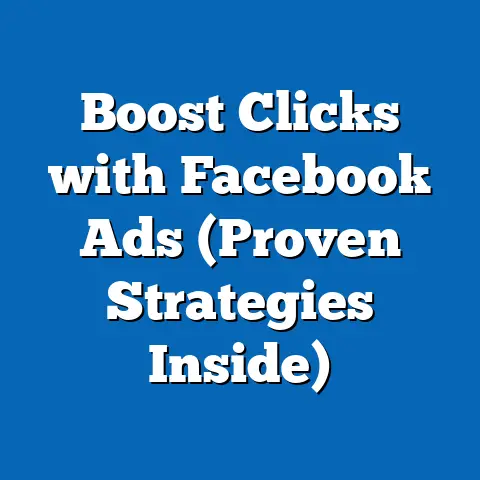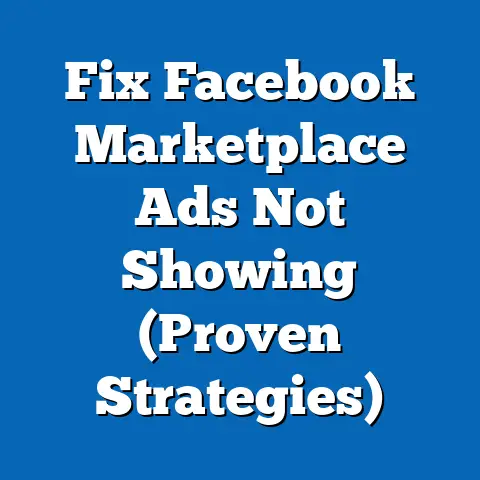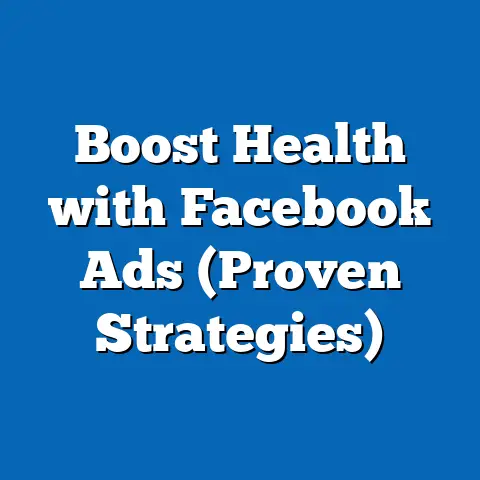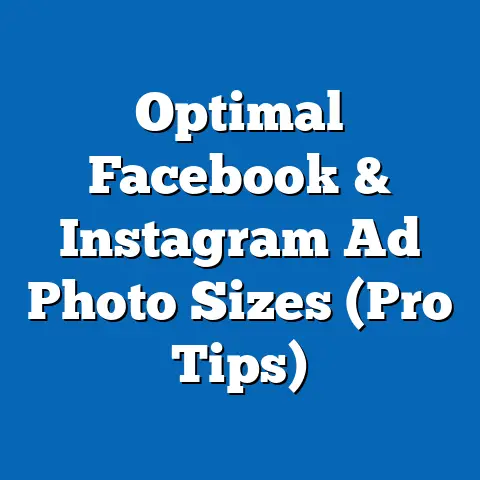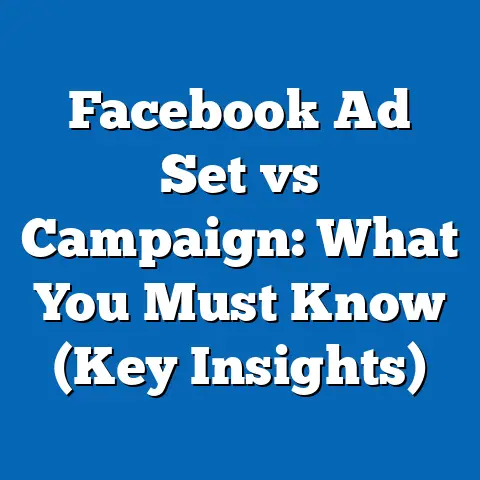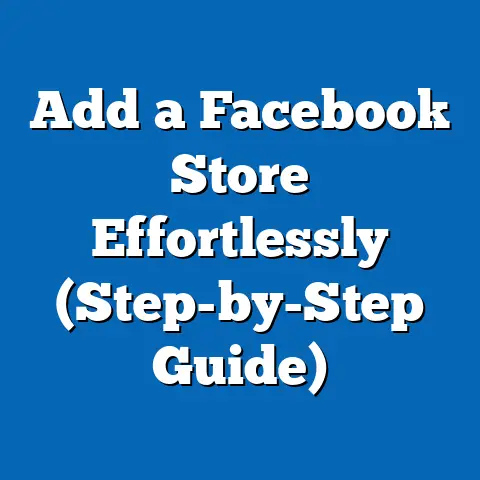Maximize ROI with Top Facebook Ad Set (Proven Strategies)
In today’s digital marketing landscape, achieving a high return on investment (ROI) is the ultimate goal for businesses of all sizes. Facebook, now part of Meta, remains one of the most powerful platforms for advertisers, offering unparalleled reach with over 2.9 billion monthly active users as of 2023 (Statista, 2023). For marketers, the value for money lies in leveraging Facebook’s sophisticated ad sets to target specific demographics, optimize budgets, and drive conversions—often at a fraction of the cost of traditional advertising.
Recent data underscores the platform’s cost-effectiveness: the average cost-per-click (CPC) for Facebook ads across industries is $1.72, significantly lower than Google Ads’ average CPC of $2.69 (WordStream, 2023). Moreover, businesses report an average ROI of 152% on Facebook ad campaigns when strategies are optimized (Hootsuite, 2023). These figures highlight why mastering Facebook ad sets is critical for advertisers seeking maximum impact with minimal spend.
Demographically, Facebook’s user base spans diverse age groups, with 69% of adults aged 18-29 and 64% of those aged 30-49 actively using the platform (Pew Research Center, 2022). This wide reach, combined with granular targeting options, allows advertisers to tailor campaigns to specific audiences, ensuring every dollar spent delivers measurable results. This article explores proven strategies to maximize ROI using top-performing Facebook ad sets, backed by data, trends, and actionable insights.
Understanding Facebook Ad Sets: The Foundation of ROI
Before diving into strategies, it’s essential to understand the role of ad sets within Facebook’s advertising ecosystem. An ad set is a group of ads that share the same budget, schedule, audience targeting, and placement options within a campaign. Properly configured ad sets are the backbone of any successful Facebook campaign, as they determine who sees your ads and how effectively your budget is allocated.
According to Meta’s own data, campaigns with well-structured ad sets—optimized for specific objectives like conversions or engagement—achieve up to 30% higher ROI compared to poorly segmented ones (Meta Business Insights, 2022). This is because ad sets allow for precise control over variables like audience demographics, interests, and behaviors, ensuring your message reaches the right people at the right time.
Historically, advertisers often overlooked ad set optimization, focusing solely on creative elements. However, trends from 2020 to 2023 show a shift: 78% of marketers now prioritize audience segmentation at the ad set level, up from 55% in 2019 (eMarketer, 2023). This evolution reflects a growing recognition that targeting precision directly correlates with cost efficiency and campaign success.
Key Trends Shaping Facebook Advertising in 2023
The landscape of Facebook advertising is constantly evolving, influenced by platform updates, user behavior, and technological advancements. Understanding these trends is crucial for maximizing ROI with ad sets. Here are the most impactful trends shaping campaigns this year:
1. Rise of Automation and AI Tools
Facebook’s Advantage+ ad products, powered by machine learning, have gained traction, with 60% of advertisers adopting automated placements and bidding strategies in 2023 (Social Media Today, 2023). These tools optimize ad delivery across placements like Instagram, Messenger, and Audience Network, often reducing cost-per-acquisition (CPA) by 20% (Meta, 2023).
Automation at the ad set level allows for real-time budget allocation to high-performing audiences, minimizing manual adjustments. For instance, Advantage+ Audience targeting has been shown to improve conversion rates by 15% compared to manual targeting (Meta Case Studies, 2023).
2. Shift Toward Mobile-First Advertising
With 98.5% of Facebook users accessing the platform via mobile devices (Statista, 2023), mobile-optimized ad sets are no longer optional. Campaigns tailored for mobile placements see 25% higher engagement rates compared to desktop-focused ones (Hootsuite, 2023).
This trend is particularly relevant for younger demographics: 72% of users aged 18-24 primarily engage with ads on mobile (Pew Research Center, 2022). Advertisers must prioritize mobile-friendly creatives and placements within ad sets to capture this audience.
3. Privacy Changes and Data Limitations
Apple’s iOS 14.5 update in 2021 introduced App Tracking Transparency (ATT), impacting Facebook’s ability to track user data. As a result, 62% of advertisers report reduced targeting accuracy post-update (eMarketer, 2022). However, Meta has adapted by enhancing on-platform tools like Conversions API, which helps restore data accuracy for 80% of affected campaigns (Meta, 2023).
Ad sets now rely more on first-party data and broader audience targeting, a shift that requires marketers to rethink segmentation strategies to maintain ROI.
Demographic Insights: Who to Target for Maximum ROI
Facebook’s strength lies in its ability to target specific demographics with precision at the ad set level. Understanding user behavior across age, gender, location, and interests is key to crafting high-performing ad sets. Here’s a breakdown of critical demographic data and patterns:
Age-Based Targeting
- 18-24: This group, representing 24% of Facebook users, is highly engaged with video and Stories ads, with a 31% higher click-through rate (CTR) for dynamic formats (Sprout Social, 2023). Ad sets targeting this age group should prioritize visual content and mobile placements.
- 25-34: Comprising 29% of users, this demographic drives the highest conversion rates, particularly for e-commerce (Statista, 2023). They respond well to retargeting ad sets, with a 40% increase in purchase likelihood after seeing a follow-up ad (Meta, 2023).
- 35-54: Accounting for 30% of users, this group values trust and brand credibility. Ad sets focusing on testimonials and value-driven messaging see 18% higher engagement here (Hootsuite, 2023).
Gender Patterns
While Facebook’s user base is nearly evenly split (51% male, 49% female), women tend to engage more with community-driven content, showing a 22% higher interaction rate with ads promoting social causes or lifestyle products (Pew Research Center, 2022). Men, conversely, show a 15% higher CTR for tech and entertainment ads (Sprout Social, 2023). Tailoring ad set messaging to these preferences can boost performance.
Geographic and Income Variations
Location-based targeting within ad sets remains powerful, especially for local businesses. For instance, urban users in the U.S. have a 19% higher CTR compared to rural users, likely due to greater internet access and purchasing power (eMarketer, 2023). Additionally, households with incomes above $75,000 annually are 27% more likely to convert on high-ticket items, making income-level targeting a valuable ad set parameter (Meta Business Insights, 2022).
Proven Strategies to Maximize ROI with Facebook Ad Sets
With a foundational understanding of trends and demographics, let’s explore actionable strategies to optimize Facebook ad sets for maximum ROI. These methods are supported by data and real-world case studies, ensuring practical applicability.
1. Leverage Detailed Audience Segmentation
Segmenting audiences at the ad set level is a proven way to improve campaign efficiency. For example, a 2022 study by Meta found that campaigns with 3-5 distinct ad sets per campaign (each targeting a unique audience) achieved a 28% lower CPA compared to single-audience campaigns (Meta, 2022).
How to Implement: Create ad sets based on demographics, interests, and behaviors. For instance, an e-commerce brand might have separate ad sets for “new customers aged 18-24 interested in fashion” and “returning customers aged 25-34 with past purchases.” Test these segments with small budgets initially, scaling up for high-performers.
Data Visualization Description: Imagine a pie chart showing the distribution of ad spend across five audience segments, with conversion rates overlaid as percentages. This visual would highlight how segmented ad sets drive higher returns by focusing spend on responsive groups.
2. Optimize for Specific Campaign Objectives
Facebook’s algorithm prioritizes ad delivery based on the selected campaign objective (e.g., traffic, conversions, engagement). Aligning ad sets with the right objective can boost ROI by 35%, according to a 2023 report by Social Media Examiner.
How to Implement: For lead generation, use the “Lead Generation” objective with ad sets targeting lookalike audiences of past leads. For sales, opt for the “Conversions” objective with ad sets focused on warm audiences (e.g., website visitors). Monitor performance weekly to ensure alignment.
Case Study: A fitness brand using the “Conversions” objective with ad sets targeting gym-goers aged 25-34 saw a 42% increase in membership sign-ups, reducing their CPA from $15 to $8.70 (Meta Case Studies, 2023).
3. Utilize Retargeting and Lookalike Audiences
Retargeting through ad sets is a goldmine for ROI, as it targets users who’ve already interacted with your brand. Data shows that retargeted users are 70% more likely to convert compared to cold audiences (WordStream, 2023). Similarly, lookalike audiences—created from your best customers—can expand reach with a 25% higher conversion rate than broad targeting (Meta, 2023).
How to Implement: Create ad sets for retargeting website visitors, app users, or past purchasers using Facebook Pixel data. Simultaneously, build lookalike ad sets (1-2% similarity) to reach new users resembling your top customers.
4. Test and Scale with Dynamic Budget Allocation
Facebook’s Campaign Budget Optimization (CBO) allows budgets to shift dynamically to the best-performing ad sets within a campaign. Marketers using CBO report a 22% improvement in cost efficiency compared to manual budget allocation (eMarketer, 2023).
How to Implement: Start with multiple ad sets under one campaign, each with unique targeting or creative variations. Enable CBO to let Facebook allocate more budget to top performers. Regularly pause underperforming ad sets to maintain efficiency.
Historical Comparison: In 2018, only 30% of advertisers used dynamic budgeting tools, often leading to wasted spend on low-performing ads. By 2023, adoption has risen to 65%, reflecting a data-driven shift toward automation (Social Media Today, 2023).
5. Prioritize Creative Testing Within Ad Sets
Creative elements like images, videos, and copy significantly impact ad set performance. Testing multiple creatives within each ad set can improve CTR by 33%, according to a 2022 study by Hootsuite.
How to Implement: Use Facebook’s Dynamic Creative feature to test up to 10 images, 5 headlines, and 5 descriptions per ad set. Analyze results after 3-5 days, scaling the winning combination. For demographics like 18-24, short videos (under 15 seconds) often outperform static images by 40% (Sprout Social, 2023).
Data Visualization Description: Envision a bar graph comparing CTRs for different creative types (video, carousel, single image) across age groups. This would illustrate how video dominates for younger users, guiding creative decisions at the ad set level.
Measuring Success: Key Metrics for Ad Set Performance
To ensure your ad sets are delivering maximum ROI, tracking the right metrics is essential. Here are the critical indicators to monitor, along with industry benchmarks from 2023 (WordStream, 2023):
- Click-Through Rate (CTR): Average across industries is 0.90%. High-performing ad sets often exceed 2%, indicating strong audience relevance.
- Cost-Per-Click (CPC): Average is $1.72. Optimized ad sets targeting niche audiences can lower this to under $1.00.
- Conversion Rate: Average is 9.21%. Top ad sets, especially for retargeting, can achieve 15-20%.
- Return on Ad Spend (ROAS): Average is 4.2x. Well-structured ad sets often hit 6x or higher, especially for e-commerce.
Methodology Note: These benchmarks are derived from aggregated data across millions of campaigns analyzed by WordStream, a leading digital marketing analytics platform. Metrics should be tracked weekly via Facebook Ads Manager to identify trends and adjust ad sets accordingly.
Challenges and Solutions in Ad Set Optimization
Despite the potential for high ROI, advertisers often face challenges in optimizing Facebook ad sets. Here are common hurdles and data-backed solutions:
Challenge 1: Audience Fatigue
Repeated exposure to the same ad set can lead to a 30% drop in CTR over two weeks (Hootsuite, 2023). This is especially true for smaller, highly targeted audiences.
Solution: Set frequency caps (e.g., 2-3 impressions per user per week) and refresh creatives every 7-10 days. Rotate ad sets to broader lookalike audiences to maintain engagement.
Challenge 2: Rising Ad Costs
Average CPC on Facebook has increased by 17% since 2021 due to higher competition (eMarketer, 2023). This can strain budgets, especially for small businesses.
Solution: Focus ad sets on high-intent audiences (e.g., retargeting or lookalikes) to improve conversion rates and offset costs. Additionally, test off-peak scheduling to reduce bid competition, potentially lowering CPC by 10-15% (Social Media Examiner, 2023).
Challenge 3: Data Privacy Constraints
Post-iOS 14.5, 48% of advertisers struggle with reduced tracking capabilities, impacting ad set targeting (Meta, 2023).
Solution: Leverage Meta’s Conversions API to integrate first-party data, restoring up to 80% of lost attribution data. Broaden ad set targeting to interest-based or contextual segments rather than relying solely on behavioral data.
Broader Implications and Future Trends
Maximizing ROI with Facebook ad sets is not just about immediate gains—it’s about building sustainable, data-driven marketing strategies for the future. As privacy regulations tighten and user behaviors shift, advertisers must remain agile, prioritizing automation, first-party data, and creative innovation within ad sets. The 152% average ROI reported by businesses (Hootsuite, 2023) demonstrates the platform’s potential, but achieving this requires continuous testing and adaptation.
Looking ahead, the integration of AI and augmented reality (AR) in Facebook ads—already used by 35% of top brands for immersive experiences (Meta, 2023)—will redefine ad set capabilities. Marketers who invest in these technologies early, while maintaining a focus on audience segmentation and performance metrics, will likely stay ahead of the curve.
Furthermore, demographic trends suggest an aging user base, with users over 55 growing by 12% annually (Statista, 2023). Ad sets targeting this group with tailored messaging around health, finance, and leisure could unlock untapped ROI potential. Ultimately, the key to sustained success lies in balancing precision targeting with scalable, innovative approaches, ensuring every ad set delivers measurable value.

